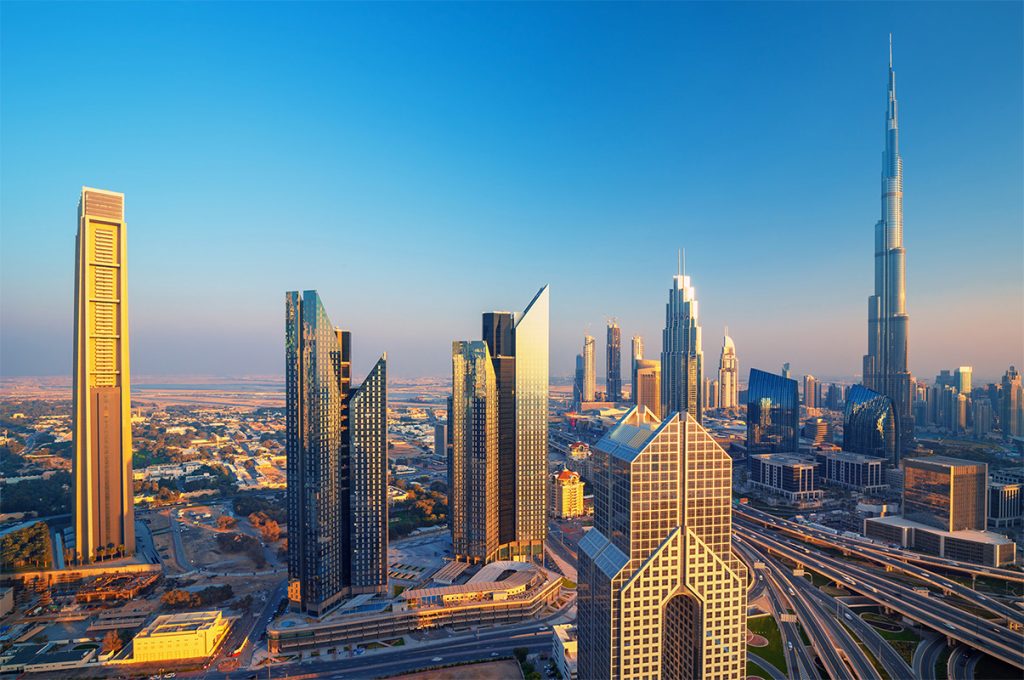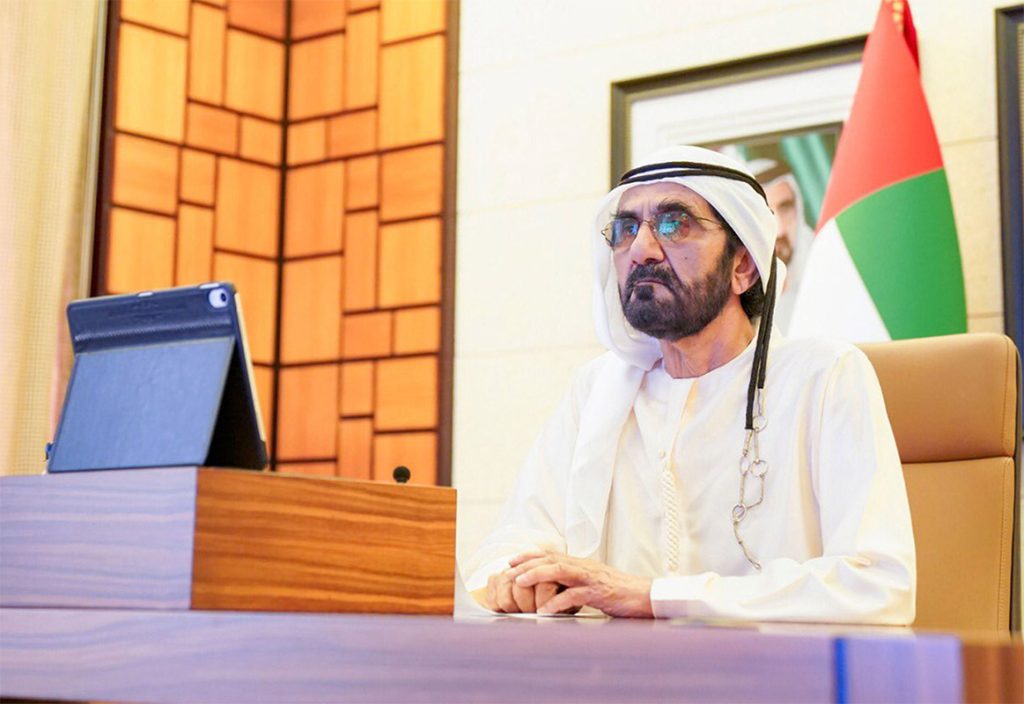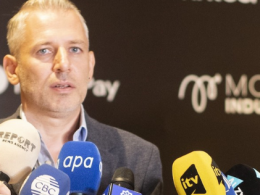For most in the global financial markets, the COVID-19 pandemic in 2020 hit like a bolt out of the blue. Governments responded in full force, with lockdowns and associated restrictions to stem the spread of the virus. And suddenly, aviation, tourism, hospitality, energy, and so many other sectors flatlined, erasing trillions of dollars in investors’ assets. One particular event that no one will forget in a hurry is the price of oil futures descending into negative territory, for the first time in history, in April 2020.
All of this hit the UAE markets especially hard; because not only do oil exports constitute at least 35% of government revenues but also tourism makes up over 11% of the country’s GDP. Not to talk about international trade, which has a 161% ratio to GDP. As a result, the UAE economy declined by a whopping 6.1%. Individual sectors, such as food services and accommodation, shrank by up to 24%.
Nevertheless, adaptation is a central feature of human behavior; and by adapting to the conditions of the pandemic, investors discovered new approaches to the markets and altered their behaviors. We may never recover all that was lost, but there are some important lessons that we have come away with.
Impact of the COVID pandemic on the financial markets
Before we can learn what new behaviors investors and other participants in the markets have picked up, we have to first understand exactly the effects that the pandemic had on the markets.

Declining oil prices
The most immediate impact of the COVID pandemic on the UAE economy was felt through the sharp decline in oil prices. Although oil prices are now safely above $100, they reached as low as $12 during the heat of the pandemic, especially following the brief rift between Russia and the Kingdom of Saudi Arabia at the time.
And since the UAE relies on oil exports for up to 35% of government revenues, the country’s fiscal plans were significantly affected, widening the fiscal deficit. And individual and institutional investors who had positions in the oil industry had to take huge losses, occasioned both by low demand and low prices.
Lower credit ratings
Currently, the biggest discussion about economies in the west is their governments’ decision to raise interest rates; with many predicting that it would precipitate a recession. And as we all well know, national and international markets depend critically on access to and cost of credit.
This very vital pillar was also seriously impacted by the COVID pandemic. Since entire sectors of economic activity almost or entirely stopped, rating agencies dropped the ratings of credit facilities across multiple sectors of the UAE’s economy. This action depressed debt quality and raised the cost of loans, further cutting into profit margins for many individual and institutional investors who typically carry some amount of debt on their balance sheets.
Expanded liquidity and resulting inflation
To support businesses and prevent even worse economic fates in the wake of the pandemic, central banks around the world embarked on various expansionary measures.
In the UAE, some of the actions that were taken by the central bank include:
- A six-month-long waiver on fees for payment services that it provides to banks.
- A raft of relief funds for the banking sector, totaling up to AED 256 Billion – AED 61 Billion reduction in capital requirements, AED 50 Billion no-interest support, AED 95 Billion liquidity buffer relief, and AED50 Billion in capital buffer relief.
- Permitted banks to access up to 60% of their capital conservation buffer.
However, all of these measures put inflationary pressures on the economy, leading to the devaluation of individual and institutional investors’ assets. In April 2022, the inflation rate in the UAE stood at 4.6%. Although it’s still much lower than in the US (8.6%) and the UK (9.1%), it’s the highest that the country has seen since 2015.
A decline in the non-oil sectors
Despite being an oil-producing country, the United Arab Emirates has diversified its economy into sectors other than oil. Due to significant investments in infrastructure and human capital development, the country now has multiple sectors thriving simultaneously.
Even these were not immune to the effects of the COVID pandemic. The trade and tourism sectors were the most spectacularly affected.
● Tourism
In 2019, air travel and tourism constituted a combined 16.5% of the UAE’s entire GDP. However, due to the flight restrictions that were put in place to control the spread of the pandemic, air travel all but came to a halt. Also, hotel occupancy rates fell as low as 20%, from highs of above 85%, even when average room rates were halved.
● International trade
In the UAE, exports typically account for almost 94% of GDP, while imports can reach 67%. All of these were significantly hampered as a result of the pandemic. For example, the UAE’s imports from China, $28.6 Billion in 2019, were completely halted in 2020.
How did investment companies fare during and after the pandemic?
The impact of all these on businesses and investors operating in these sectors hardly needs any further explanation. And even though much of the pandemic is behind us now, the markets and investors are still left dealing with its after-effects. We have relatively returned to normalcy, but growth will be gradual, and companies are still struggling to return their balance books to the state that they were in before the pandemic.
The Evergrande Group
One of the standout stories is of the Evergrande Group – a Chinese property developer. Dubbed the world’s most indebted company, Evergrande had racked up more than $300 Billion in debt and associated financing. Leverage that it had considered safe, considering the pace and state of the Chinese economy before COVID struck.
Over the past few decades, the Chinese economy has grown at an astounding rate – averaging 9.16% annually between 1989 and 2022. And as expected, this growth has created a burgeoning middle class and a new elite class – a mass of potential buyers for new real estate developments. But, with the pullback triggered by the pandemic, Evergrande suddenly found itself earning less than it needed to meet its debt obligations and thus defaulted.
The Dubai Investment Fund (DIF)
Regardless of the circumstances, a few companies have managed to remain relatively healthy. By adopting innovative asset management techniques, especially expert asset deployment and redeployment, they have been able to ride out the pandemic and return to profitability in the shortest time.
The Dubai Investment Fund (DIF) was one of the few investment companies that managed to stay above water despite all the turmoil during the pandemic period and in the years following it. Thanks to a combination of successful management decisions, rising oil prices, and well as returning activity in the non-oil sectors, the company received an operating income of AED 14.3 Billion in 2021, off revenues of AED 180.7 Billion, a 27% increase year-on-year, total assets amounted to AED 1,184.6 billion and total equity amounted to AED 878.1 billion.
Emirates NBD
Another is Emirates NBD. Although they suffered significant losses during the pandemic years, they have recovered quite fast, posting healthy results for 2021. In that year, their net profit rose by 34% year on year – a whopping AED9.3 Billion. And on the strength of this, they were able to increase dividends by 25% – just 1 year after the pandemic’s worst periods.
How have investors’ behaviors changed?
During the pandemic and in the months following, significant shifts have occurred in the financial markets. In this section, we examine some of them.

Popularization of cryptocurrency and retail investing
Forced to sit at home by lockdowns and flush with stimulus funds, regular people took up retail investing by the millions, driving up activity majorly in the cryptocurrency space. Bitcoin and all the other major crypto coins, and even some meme coins, all reached major all-time highs. Also, NFTs rose to prominence, eventually recording billions of dollars in transactions, including high-profile ones like Beeple’s $69 Million digital art and Twitter founder Jack Dorsey’s first tweet that sold for $48 Million.
The size of the cryptocurrency market grew astronomically, reaching as high as $1 Trillion in January 2021. And despite facing backlash from regulators and tightening laws, it remains a preferred asset class for many retail investors.
Rapidly increasing and then reduced venture capital enthusiasm
Over the past few years, venture capital has climbed to previously unimaginable heights. Again, buoyed by excess liquidity in the system, VC investments set a new record in 2021 – $631 Billion, 111% higher than the previous year.
But, faced with contractionary measures instituted by governments to stem inflation, a lot of startups buckled under pressure. Valuations were lost, and some folded entirely. For example, Fast, a startup providing checkout solutions for online commerce, folded in April this year. This was barely a year after raising $102 Million in its Series B funding round. The company was last valued at $580 Million and raised a total of $124.5 MIllion across multiple funding rounds. And all of that went to zero when it folded. And that’s just one out of many.
So, almost as fast as it had risen, VC enthusiasm quickly dipped. Investors have returned to the fundamentals – carrying out traditional due diligence on startups seeking funding to probe for market fit, revenue model, minimum viable products, and all other KPIs. And as a result, VC funding has slowed significantly.
Technology is the future
Even though for many, it was a bubble devoid of substance, another lesson that has persisted from the pandemic days is the potential that the technology sector holds. Despite the many stories of doom, there were a few success stories in the tech and innovation sectors.
EV manufacturer Tesla is one of the biggest beneficiaries of the tech boom. Thanks to their innovative technology, and consistent financials, they recorded a 784% increase in market valuation in one single year, between December 2019 and December 2020.
So, despite the crash in startup valuations, investors have continued to pile into tech stocks in the stock markets. For example, even though Cathie Wood’s (ARK Invest) much-publicized Innovation ETF has lost 53.39% year to date, it remains heavily subscribed.
The rise in the prominence of ESG considerations
One of the most spectacular aftereffects of the COVID pandemic is that companies are now more concerned than ever about environmental, social, and governance issues. During the lockdowns, social media discussions came to focus on the contributions of companies to the general well-being. This was made even further important by other non-related events, like the gas pipeline fire in the Gulf of Mexico in 2021, the Evergreen container ship getting stuck in the Suez canal, social justice demonstrations around the world, and so many others.
Today, ESG considerations are now a major aspect of decision-making for individual and institutional investors. And if you check any random investment fund’s website, chances are that they have a separate section dedicated to outlining their ESG objectives, and how they enforce them in their business activities and in their portfolio companies.
Even though ESG considerations may not translate directly into cash, they do translate into goodwill. And goodwill opens the doors for both new capital and more profitable dealmaking.
Increase in frequency of M&As and other non-buyout deals
Cash-strapped, following the shrinkage in activity brought about by the pandemic, companies began to find ways to restructure their businesses – to open up new capital injections, and reduce liabilities. And one of the methods that they began to exercise at a high frequency is non-buyout dealmaking.
Leveraged buyouts and wholesale acquisitions are usually loudly accompanied by ridiculously huge costs. Elon Musk’s recently aborted acquisition of Twitter, for example, would have cost $44 billion. And as we already well know, companies barely had that much wiggle room to play around during the pandemic.
Instead, they began to embark on mergers, debt-backed transactions, smaller-sized private M&As, restructurings, and so on.
Private equity companies, especially, carried out a higher frequency of bolt-on acquisitions. This way, they could combine their portfolio companies and their resources, shed excess toxicity, improve their economies of scale and optimize their capital efficiency ratios without having to spend an arm and a leg on outsized transactions.
The UAE government’s plans for the future
Just like any other responsive government would do, the government of the UAE has taken the bull by its horn in drawing out blueprints for the future of the UAE’s economy, not only concerning COVID recovery but also for future realities.

Operation 300Bn
The UAE government has become actively involved in sustainability aspirations; it was the first in the Middle East to sign up for the Paris Agreements. In 2021, the Ministry of Industry and advanced technology declared Operation 300bn – an ambitious ten-year plan to grow the UAE’s industrial sector from AED133 Billion to AED300 Billion by 2031. The plan outlines strategies that specifically highlight national ESG goals – sustainable economic developments, clean energy, industrial innovation, and responsible consumption and production.
The government has also outlined a raft of other strategies:
- The UAE Vision 2021
- The UAE Centennial 2071
- The UAE Energy Strategy 2050
- The National Climate Change Plan 2050
- The UAE Circular Economy Policy 2021‑2031
National AI Strategy 2031
We have noted earlier how the potential of the technology sector has come to the front burner in investing circles. Well, the UAE government has not been oblivious to that fact. To better position the country to earn the most benefits from this tech revolution, the UAE introduced its National AI Strategy 2031 last year. It also introduced the UAE National Program for Artificial Intelligence.
Already, the UAE is the primary center for fintech activity in the middle east – the San Francisco of the MENA region, if you will. Almost 50% of fintech startups in the region are based in the country. But with these new strategies, the government seeks to entrench itself even further at the center of technological innovation in the entire middle eastern region and possibly the world.
Its stated objectives are:
- Positioning the UAE as a world leader in artificial intelligence by 2031.
- Increased productivity and economic growth by employing artificial intelligence technologies.
Primarily, this drive is focused on the following sectors:
- Resources and energy.
- Logistics and transportation.
- Tourism and hospitality.
- Healthcare.
- Cybersecurity.
Attracting even more FDI
The UAE is well known for its significant population of expatriates and foreign companies. With people drawn from more than 190 countries across the globe, the UAE has an expatriate population of 8.89 Million, 89% of the country’s population. And they have been highly instrumental in building its economy – the less-skilled workers work construction while the professionals contribute to corporate offices across the country.
However, seeking even more growth and foreign direct investment, the UAE government has taken measures to expand access for expatriates and foreign investors seeking to invest in the country.
These measures include:
- Allowance for an unprecedented 100% foreign equity ownership across; manufacturing, technology, and a host of other sectors of the economy;
- Golden visas for investors, researchers, and expatriates;
Among other bilateral actions with other governments in the middle east and Asian regions.
Conclusion
The COVID pandemic brought on tough conditions for investors, businesses, governments, and common people alike. Not a few companies went under, having buckled under the pressure of economic restrictions and sinking revenues.
However, by deploying novel business management practices, some companies could stay afloat through it. And in the subsequent period, investors and businesses have begun to adopt strategies to not only regain their previous strength but also optimize for success in a post-COVID world.
With adequate support from the government and proper coordination, investors and the financial markets can steer companies to build a world economy that’s more sustainable, equitable, and resilient than what we had pre-COVID.









